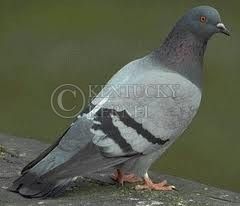Pigeons help explain gambling behavoirs

October 24, 2010
When it comes to studying the gambling habits of people, perhaps the last thing anyone would expect is an experiment involving pigeons, but that is exactly what UK psychology professor Thomas Zentall is doing.
By having pigeons decide whether to gamble for a large amount of food or recieve a consistent small amount of food, Zentall’s experiment has given interestin insight into why people gamble.
“There’s a fundamental attraction to the jackpot that doesn’t seem to require a lot of cognitive functioning or the complexity of human thought behavior,” said Zentall. “There’s something fundamental about the behavior of animals in general that they’re attracted to this. We call it ‘maladaptive behavior.’”
In Zentall’s study, pigeons choose between a light on the right and a light on the left. The light on the left changes to either red or green. If it turns green, the pigeons are awarded ten pellets, but if it turns red, they get nothing at all. The light on the right turns either yellow or blue, but no matter which color it turns, the pigeons are always awarded three pellets.
“The rationale for human gambling is complex,” Zentall said. “Some people argue that humans gamble because they don’t understand the odds. For animals, you have to go through the experience. People say it’s fun to gamble, but for an animal it shouldn’t be fun to gamble because it decreases their probability of being fed.”
Zentall has observed several factors that influence how much the pigeons gamble, and those factors are often similar to why people are influenced to gamble.
“How hungry the pigeon is can make a difference,” Zentall said. “The environment can make a difference. Generally, people who can afford the expense less gamble more, and the same is true for pigeons. The hungrier they are, the less efficient they are as they try to gamble for more food.”
Using pigeons to study gambling habits has its benefits and can be far easier than using people, Zentall said, since an experiment requires manipulating various factors and conditions, like the environment.
“Its really hard to get people to volunteer for a control group,” said Zentall. “With animals we can assign conditions so we can observe differences between the two groups.”
Using animals to figure out certain aspects of human behavior is nothing new to science.
“If we have an animal model, we can find ways to manipulate the animal’s environment or certain characteristics that will vary the degree to which it will gamble,” Zentall said. “That way we can find treatments for gamblers. If you have a model for a human behavior, you can begin to look at ways of reducing the likelihood of that behavior.”
So what does the experiment suggest would be an effective treatment for those with gambling problems? The environment might be one of the most primary factors, Zentall said.
“If we think environment makes a difference, one form of therapy would be to get gamblers involved in outside interests like sports, clubs and hobbies,” Zentall said. “That way, they don’t need to look to gambling for a sense of pleasure.”
The experiment has picked up an immense amount of attention from all over the world. Zentall has been contacted by BBC, CBC and a radio station in New Zealand among others to discuss the experiment and what it says about gambling habits.
“It’s creating quite a lot of interest,” said Zentall.



























































































































































